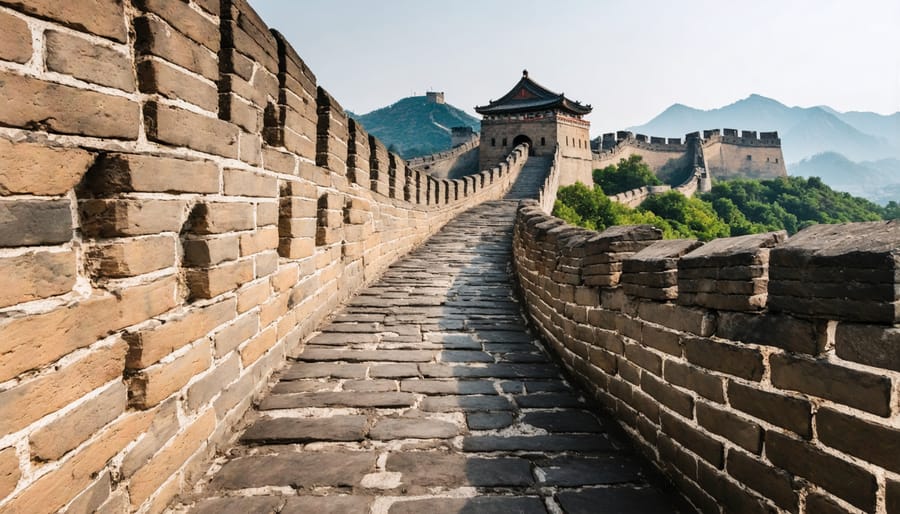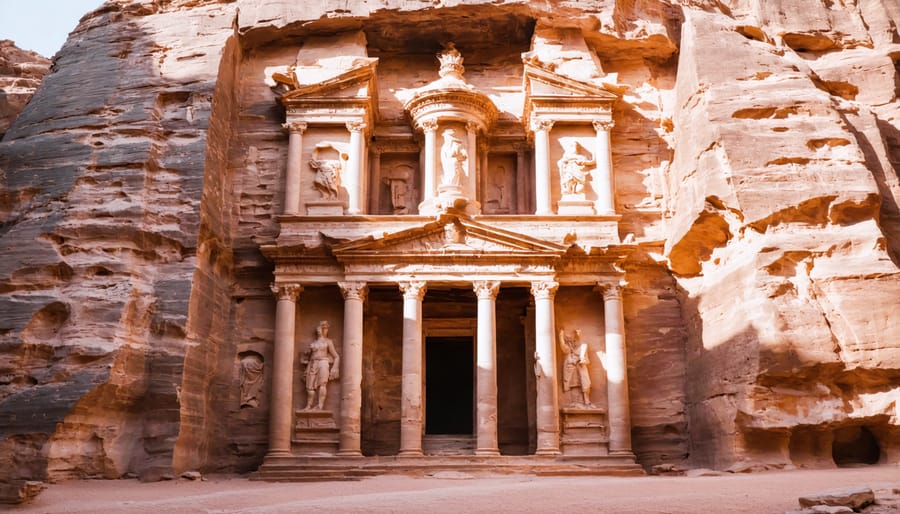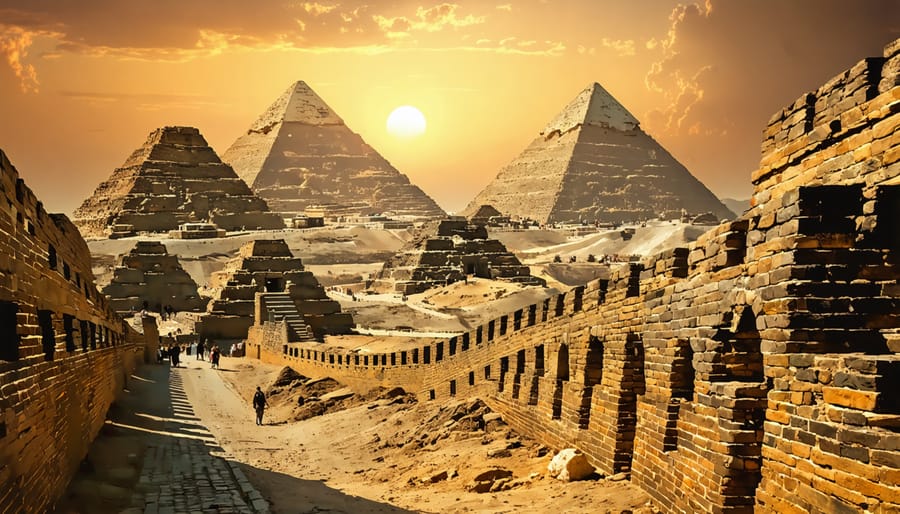Standing defiantly against time, seven ancient monuments continue to captivate our imagination and reveal cultural stories carved in stone. These architectural marvels—from the towering Great Pyramid of Giza to the intricate stonework of Petra—demonstrate humanity’s mastery over stone and our enduring drive to create lasting legacies.
While countless ancient structures have crumbled, these seven wonders persist through millennia thanks to revolutionary engineering techniques and the remarkable durability of natural stone. Their survival offers profound insights into ancient construction methods, particularly the sophisticated understanding of material properties and structural integrity that ancient builders possessed.
Modern archaeological studies reveal that these monuments share common architectural elements: precise stone cutting, innovative weight distribution systems, and strategic material selection that enabled them to withstand earthquakes, weather, and warfare. Today, these enduring structures not only serve as testament to human ingenuity but continue to influence contemporary architectural practices in stone construction and preservation techniques.

The Great Pyramid of Giza: Engineering Excellence in Limestone
Precision Stone Cutting Techniques
The ancient Egyptians demonstrated remarkable precision in their stone cutting techniques, particularly evident in the Great Pyramid of Giza. The massive limestone blocks, weighing up to 70 tons each, were cut with such accuracy that the gaps between them measure less than 0.5 millimeters. This precision allowed the blocks to fit together seamlessly without mortar, contributing to the pyramid’s incredible durability.
Archaeological evidence suggests the builders used copper saws, bronze chisels, and wooden mallets along with water as a lubricant to cut through the limestone. They employed ingenious methods to achieve perfectly straight edges, including the use of plumb bobs and set squares. The workers would pour water into cut marks to check for level surfaces, as the water line provided a reliable reference point.
Perhaps most impressive was their understanding of geometry and surveying. The pyramid builders created precise right angles by using a rope knotted into a 3-4-5 triangle, demonstrating advanced mathematical knowledge. This combination of precise tools, technical expertise, and mathematical understanding resulted in structures that have withstood over 4,500 years of environmental challenges.
Structural Integrity Through Millennia
The remarkable longevity of ancient wonders can be attributed to sophisticated engineering principles that were far ahead of their time. The pyramids of Giza, for instance, employ a precise geometric design with massive limestone blocks fitted so tightly that even today a knife blade cannot be inserted between them. This precision, combined with a wide base and carefully calculated weight distribution, has enabled their survival for over 4,500 years.
The Romans’ mastery of concrete technology played a crucial role in the Colosseum’s endurance. Their unique mixture, incorporating volcanic ash, created a material stronger than modern Portland cement, allowing the structure to withstand earthquakes and centuries of weathering. Similarly, the Great Wall of China’s durability stems from its rammed earth construction technique, where builders compressed layers of earth mixed with natural stone, creating an incredibly dense and stable core.
Ancient builders also demonstrated remarkable understanding of site selection and foundation preparation. Petra’s structures, carved directly into rose-colored limestone cliffs, have remained protected from erosion due to their strategic positioning and natural drainage systems. These engineering achievements continue to influence modern architectural practices and stone construction techniques.
The Great Wall of China: Masters of Stone Fortification
Local Stone Selection and Processing
The ancient builders demonstrated remarkable stone artistry in architecture, carefully selecting and processing local materials for maximum durability. The Great Pyramid of Giza primarily used limestone quarried from nearby Tura, with granite elements sourced from Aswan. These massive blocks were precisely cut using copper chisels, wooden mallets, and bronze saws with sand abrasives. At Petra, craftsmen carved directly into rose-colored sandstone, taking advantage of the rock’s natural layering to create intricate facades. The Great Wall of China incorporated locally quarried granite and limestone, with rammed earth cores in some sections. Workers developed sophisticated techniques for stone transportation, including wooden rollers and sledges, while using water to prevent cracking during the cutting process. These methods, though primitive by today’s standards, proved remarkably effective, as evidenced by these structures’ longevity.
Mortar and Binding Techniques
Ancient builders developed remarkable mortar formulations that have withstood millennia of weathering. The Great Wall of China’s durability can be attributed to its unique sticky rice mortar, a mixture of rice paste and limestone that created an extraordinarily strong binding agent. This innovative formula proved stronger than pure lime mortar and helped the structure survive over 2,000 years.
The Egyptians utilized gypsum and lime mortars in pyramid construction, often mixing in local materials like clay, sand, and ash to enhance durability. In the Pyramids of Giza, limestone blocks were fitted so precisely that many sections required no mortar at all, with gaps between stones measuring less than a millimeter.
Roman engineers revolutionized construction with their famous pozzolanic cement, combining lime with volcanic ash. This waterproof mortar, used in structures like the Pantheon, actually strengthens over time through a chemical reaction that continues for centuries, explaining why many Roman buildings remain intact today.

Petra: The Rose City Carved in Stone
Sandstone Carving Methods
The ancient Nabataeans carved Petra’s magnificent structures directly into rose-colored sandstone cliffs using surprisingly sophisticated methods. Unlike modern stone quarrying techniques, their approach involved working from top to bottom, carefully chiseling away excess rock to reveal columns, doorways, and intricate details. Craftsmen used iron picks, chisels, and hammers to create precise cuts, while copper tools were employed for finer decorative work. They leveraged natural rock bedding planes and joints to their advantage, reducing the risk of fractures during carving. Most impressively, they developed a system of water channels carved into the rock face to prevent erosion during seasonal rains – a feature that has helped preserve these structures for over two millennia. Their mastery of sandstone carving created not just buildings, but an entire city that has withstood the test of time.

Natural Weathering Protection
Ancient builders incorporated remarkable architectural features to protect their monuments from natural weathering. The Great Pyramid’s polished limestone casing stones were precisely angled to deflect rain and wind, while their tight-fitting joints prevented water infiltration. At Petra, the ingenious Nabataean architects carved water channels and cisterns into the rock face, directing destructive rainwater away from the elaborate facades.
The Greeks demonstrated equal foresight in constructing the Parthenon. Its slight upward curve, known as entasis, not only created visual harmony but also facilitated rainwater runoff. Similarly, Machu Picchu’s builders integrated sophisticated drainage systems with over 130 channels beneath the city, protecting the structures from erosion during heavy rainfall.
These architectural solutions, combined with the careful selection of durable building materials like granite and limestone, have helped these monuments withstand millennia of exposure to the elements, offering valuable lessons for modern stone construction.
Modern Preservation Challenges and Solutions
Contemporary Stone Conservation Methods
Modern conservation efforts employ advanced techniques to protect these ancient stone monuments. Laser cleaning removes centuries of grime without damaging delicate surfaces, while photogrammetry creates detailed 3D models to track structural changes. Conservators use specialized consolidants to strengthen deteriorating stone and apply water-repellent treatments to prevent further weathering. Climate-controlled barriers and visitor management systems help regulate environmental impacts. Scientists also monitor microscopic biological growth and use targeted biocides to prevent organic deterioration. These methods, combined with regular maintenance and documentation, ensure these magnificent structures continue to stand for future generations while preserving their historical authenticity and structural integrity.
Future Preservation Strategies
Modern preservation efforts combine cutting-edge technology with time-tested conservation methods to protect these ancient monuments. Laser cleaning techniques now allow for precise removal of harmful deposits without damaging stone surfaces. Advanced 3D scanning and modeling help architects create detailed preservation plans, while innovative protective coatings shield against environmental factors. Scientists are developing bio-based treatments that promote sustainable stone preservation through naturally occurring microorganisms. These approaches, combined with careful monitoring systems and regular maintenance schedules, ensure these magnificent structures continue to inspire future generations. Climate-controlled environments and visitor management strategies also play crucial roles in protecting these irreplaceable monuments from modern threats.
The enduring legacy of these ancient stone monuments stands as a testament to the incredible ingenuity and craftsmanship of our ancestors. From the precise mathematical calculations of the Great Pyramid of Giza to the intricate stone-cutting techniques of Petra, these structures showcase an extraordinary understanding of materials, engineering, and architectural principles that continue to amaze modern experts.
What’s particularly remarkable is how these monuments have withstood the test of time, surviving earthquakes, wars, climate changes, and countless other challenges over millennia. The durability of natural stone, combined with sophisticated construction methods, has enabled these wonders to remain standing while countless other structures have crumbled.
Today, these ancient wonders not only serve as popular tourist destinations but also as invaluable learning resources for modern architects and engineers. Their preservation techniques and structural principles continue to influence contemporary building practices, proving that the wisdom of ancient stone craftsmen remains relevant in our modern world. As we face new challenges in sustainable construction, these monuments remind us that well-crafted stone structures can truly stand the test of time.










